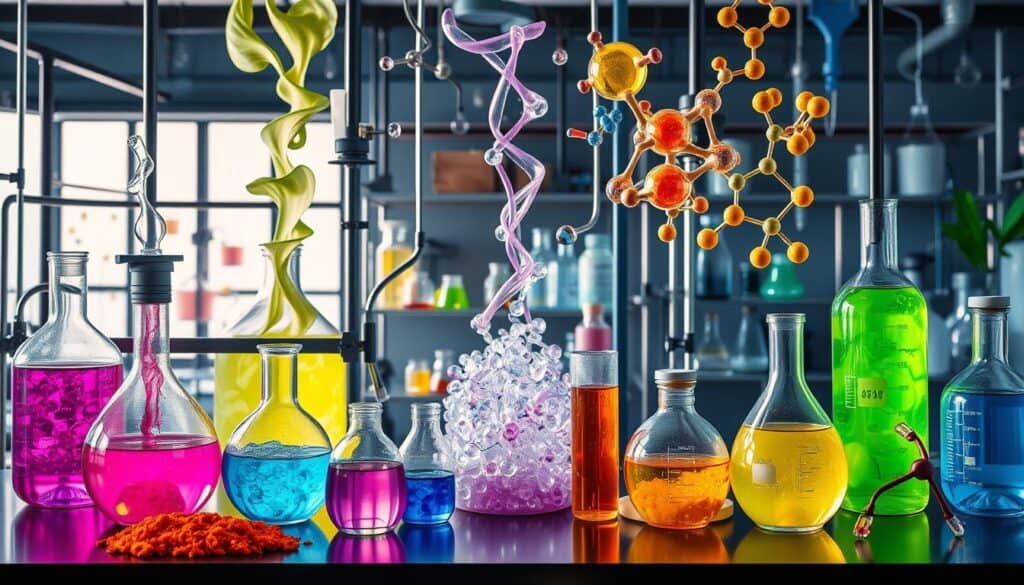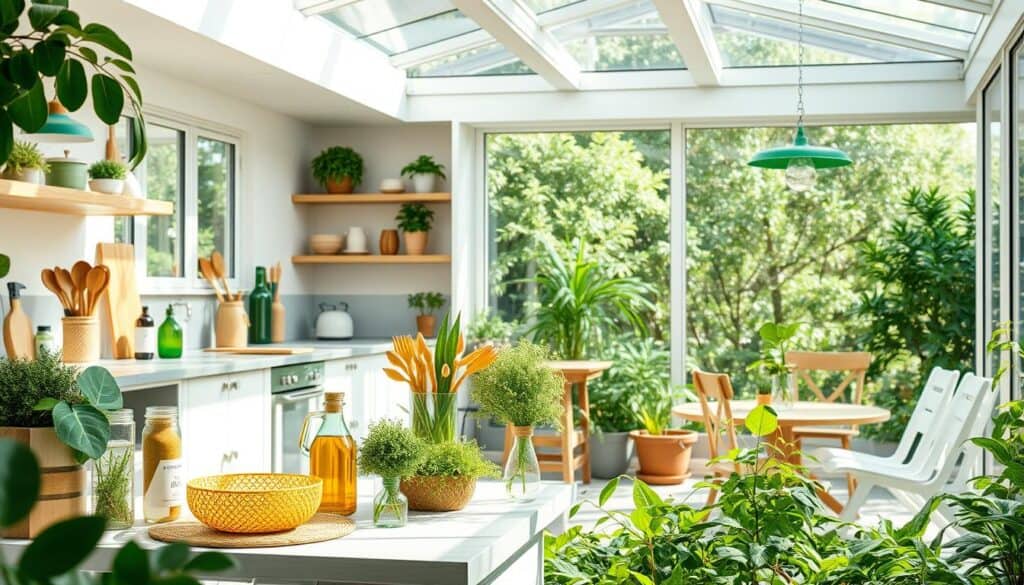Did you know that bioplastics can have up to a 25% smaller البصمة الكربونية compared to traditional fossil-based البلاستيك? Right now, 100% bio-based bioplastics are made at a rate of about 2 million tonnes each year. This is a big step towards a greener, circular economy. As people worry more about the harm of regular plastics, bio-sourced plastics are getting attention. These sustainable alternatives come from renewable sources.
النقاط الرئيسية
- Bio-sourced plastics are derived from renewable biological resources.
- Bioplastics can significantly reduce carbon footprints compared to fossil-based plastics.
- Currently, 2 million tonnes of 100% bio-based bioplastics are produced annually.
- These plastics contribute to achieving several of the United Nations’ Sustainable Development Goals.
- Bio-sourced plastics play a crucial role in enhancing the circularity of commercial plastic life cycles.
Introduction to Bio-Sourced Plastics
Bio-sourced plastics are a groundbreaking development in materials science. They offer an eco-friendlier option compared to traditional plastics made from fossil fuels.
These materials come from natural resources like plant biomass or bio-derived monomers. They represent a major step towards sustainable development, considering the environmental impact of regular plastics.
التعريف
Bio-sourced plastics are made from renewable biological resources. These can include anything from agricultural leftovers to microbes that turn organic stuff into polymers. It’s important to note not all bio-based plastics break down easily. For example, some, like PLA, need high temperatures to compost properly. This fact highlights the importance of proper waste management for these materials.
الأهمية في الاستدامة
Bio-sourced plastics play a big role in sustainability. They reduce our need for non-renewable fossil fuels, which are currently a big source of traditional plastics. Moving away from these resources cuts down on greenhouse gas emissions. It also reduces pollution from plastics that don’t break down.
Interestingly, making bio-sourced plastics often uses less energy. For instance, casein-based polyester breaks down in just 19 days, unlike regular plastics that can take over 1000 years. There’s also PHA bioplastic, made from vegetable materials. It’s used in different industries, like automotive, showing the تعدد الاستخدامات of these eco-friendly materials.
However, we must remember biodegradable plastics might not decompose in landfills. This highlights the need for effective waste management and composting. Also, these plastics can contain traces of pesticides from biomass plants. This could pose environmental and health risks.
Consumer demands and new laws, like the ban on plastic bags in some countries, are pushing bio-sourced plastics forward. The bioplastics market is expected to make up 10% of the European plastics market soon. This shows the shift towards a more sustainable plastic industry is already happening.
Sources of Bio-Sourced Plastics
Bio-sourced plastics come from various organic sources. They offer a greener option compared to traditional plastics made from oil. You can get them from plants, microbes, or even from turning waste into something useful.
Plant-Based Polymers
These polymers come from things we grow like corn, sugarcane, and potatoes. From these plants, we take starch and cellulose to make bioplastics.  Thermoplastic starch is a big deal in the bioplastics world. It represents about half of the bioplastics market.
Thermoplastic starch is a big deal in the bioplastics world. It represents about half of the bioplastics market.
Microbial Production
There’s also a cool way to make bioplastics using tiny organisms. Certain microbes can turn sugars or fats into polymers like PHA. This process takes advantage of microbes’ natural abilities to create useful bioplastics efficiently.
Waste Materials Conversion
Turning waste into bioplastics is a smart way to deal with trash and make new materials. This method uses leftover plant matter and organic waste. It helps cut down on waste and supports a cycle of reuse. It’s getting popular because it helps the environment.
| Sources | أمثلة | التطبيقات |
|---|---|---|
| Plant-Based Polymers | Corn, Sugarcane, Potatoes |
|
| Microbial Production | Polyhydroxyalkanoates (PHA) |
|
| Waste Materials Conversion | Non-food Biomass, Organic Waste |
|
Types of Bio-Sourced Plastics
Bio-sourced plastics are a key part of growing green plastic solutions. They help lessen the impact of traditional plastics on our environment. There are various types, like PLA, PHA, and Bio-PE, each with their own special properties and uses.
Polylactic Acid (PLA)
Polylactic Acid, or PLA, is a well-known biodegradable plastic. It comes from fermented plant starch, mostly from corn. People like it for packaging, disposable utensils, and compostable bags.
PLA breaks down when composted industrially. This makes it a main player in eco-friendly plastics.
Polyhydroxyalkanoates (PHA)
Polyhydroxyalkanoates, known as PHA, are biodegradable plastics made by microbes. They’re noted for being biocompatible. This makes them perfect for medical uses.
PHAs can naturally break down in the body. This makes them important for biomedical devices and medicine delivery.
Bio-Based Polyethylene (Bio-PE)
Bio-Based Polyethylene, or Bio-PE, comes from ethanol made from renewable resources like sugarcane. It offers the same features as regular polyethylene. These include being strong and flexible.
Yet, Bio-PE cuts down on carbon emissions. So, it’s a great option for many products, from packaging to consumer goods.
| النوع | Source | التطبيقات | Biodegradability |
|---|---|---|---|
| Polylactic Acid (PLA) | Plant Starch (Corn) | Packaging, Disposable Items | Industrial Composting |
| Polyhydroxyalkanoates (PHA) | Microbial Production | Medical Applications | Natural Decomposition |
| Bio-Based Polyethylene (Bio-PE) | Ethanol (Sugarcane) | Packaging, Consumer Goods | Non-Biodegradable but Recyclable |
Manufacturing Processes
The making of eco-friendly plastics comes from two main methods: chemical and biological processing. Each uses renewable resources but in different ways. They aim for sustainability and being kind to the environment.
Chemical Processing
Chemical processing turns natural materials like starch into plastics. It’s similar to how regular plastics are made but uses stuff from nature. For example, making polylactic acid (PLA) costs between $844/ton to $2,410/ton.
This method includes several steps like extracting, purifying, and making the polymer. It allows for various types of bioplastics. They can be made stronger, more heat-resistant, and work better.
Biological Processing
Biological processing involves using living things to make plastics. It’s a new way of doing things. Organisms like algae help make bioplastics that need little to grow and can be harvested all year.
This way might make more sustainable materials with less impact on the climate. Studies show that bioplastics can be better than traditional plastics in terms of carbon footprint.

Right now, such green plastics are only 1% of global production. Yet, the interest in making plastics this way is growing. More research could lead to more bioplastics and less harm to the planet.
Applications of Bio-Sourced Plastics
Bio-sourced plastics are leading us towards a sustainable future. They are used in many industries, offering an eco-friendly option. This shift towards sustainable plastic alternatives benefits both the environment and the economy.

In packaging, we often use bio-sourced plastics like Polylactic Acid (PLA). They’re found in food containers, bottles, and disposable cutlery. Because they naturally degrade, our environmental impact lowers. Grocery stores and retail...
You have read 36% of the article. The rest is for our community. Already a member? تسجيل الدخول
(وأيضًا لحماية المحتوى الأصلي لدينا من روبوتات الكشط)
مجتمع الابتكار العالمي
تسجيل الدخول أو التسجيل (100% مجاناً)
اطلع على بقية هذه المقالة وجميع المحتويات والأدوات الخاصة بالأعضاء فقط.
فقط المهندسون والمصنعون والمصممون والمسوقون الحقيقيون المحترفون.
لا روبوت، ولا كاره، ولا مرسل رسائل غير مرغوب فيها.
التعليمات
What are bio-sourced plastics made from?
Bio-sourced plastics come from materials that can grow back, unlike oil. They might be made from plants, or by microbes eating plants. Common examples include corn, sugarcane, potatoes, and plastics made by bacteria.
How do bio-sourced plastics contribute to sustainability?
They help by cutting down on fossil fuels, managing waste better, and reducing greenhouse gases. Bio-sourced plastics can be recycled or made from recycled materials, fitting into a greener cycle of use.
What are plant-based polymers?
Plant-based polymers are a big group of bio-sourced plastics. They come from plants like corn or sugarcane. These plants are turned into materials that can then be made into plastics.
Can microorganisms produce bio-sourced plastics?
Yes, certain tiny organisms can create plastics when they eat specific nutrients. This is a green way to get plastics that can break down more easily.
How is waste converted into bio-sourced plastics?
New ways have been found to turn waste and non-food plants into plastics. This not only reduces waste but is also better for the planet.
What is Polylactic Acid (PLA)?
PLA is a eco-friendly plastic made from plant starch. It’s good for the environment and is often used for things like packaging and disposable utensils.
What are Polyhydroxyalkanoates (PHA)?
PHAs are biodegradable plastics made by microbes. They are good for medical uses because they are safe for the body and break down naturally.
What is Bio-Based Polyethylene (Bio-PE)?
Bio-PE is a greener form of the common plastic polyethylene. It’s made from plant ethanol, not oil, so it’s better for the environment.
How are bio-sourced plastics manufactured?
They can be made through chemical processes or by using living organisms. The goal is to create plastics from renewable sources instead of oil.
What are the common applications of bio-sourced plastics?
You can find them in packaging, farm products, clothes, cars, and electronics. They are used in both throwaway items and longer-lasting products.
What are the environmental benefits of bio-sourced plastics?
These plastics are made from things that grow, not oil, and can break down more naturally. This reduces pollution and cuts down on greenhouse gases.
What are some challenges associated with bio-sourced plastics?
They can be expensive to make, might compete with food crops, and need special conditions to break down. These issues can make them less competitive and harder to manage at the end of their life.
How do bio-sourced plastics compare to traditional plastics?
Bio-sourced plastics use renewable resources and have less impact on the planet. Traditional plastics use oil and can harm the environment more.
What is the future of bio-sourced plastics?
The goal is to make them better, cheaper, and more functional. As people want more sustainable options, bio-sourced plastics are becoming more important.
External Links on Bio-sourced Plastics
المعايير الدولية
- ISO 16620-1:2019 Bio-based products -- Determination of bio-based carbon content -- Part 1: General principles
- ASTM D6866-21:2021 Standard Test Method for Determining the Biobased Content of Materials Using Radiocarbon Analysis
- ISO 14855-1:2012 Determination of the ultimate aerobic biodegradability of plastic materials under controlled composting conditions
(حرك الرابط لرؤية وصفنا للمحتوى)
Glossary of Terms Used
Installation Qualification (IQ): عملية موثقة للتحقق من تركيب المعدات أو الأنظمة وفقًا للمواصفات، بما في ذلك تقييم المرافق والظروف البيئية والامتثال لمتطلبات التصميم، وضمان الجاهزية للتأهيل التشغيلي.
Life Cycle Assessment (LCA): تحليل منهجي للتأثيرات البيئية المرتبطة بجميع مراحل حياة المنتج، من استخراج المواد الخام إلى الإنتاج والاستخدام والتخلص منها، بهدف تحديد فرص التحسين وإبلاغ عملية صنع القرار.












and competition with food crops?!
It’s encouraging to see the increasing use of bio-sourced plastics across various industries, but it’s important to address their end-of-life processing infrastructure. While PLA is compostable, it requires industrial composting facilities that aren’t widely available, which can limit its environmental benefits if not disposed of correctly. Expanding access to appropriate composting and recycling systems should be a priority.
Let’s push industries and governments to support research!
منشورات ذات صلة
أحدث المنشورات وبراءات الاختراع عن البيروفسكايت
أحدث المنشورات وبراءات الاختراع عن الجرافين
أكثر من 45 حيلة علمية للألعاب والتسويق: حيل تعتمد على البيانات والإحصائية
استخدام أو إساءة استخدام 25 تحيزًا إدراكيًا في تصميم المنتجات وتصنيعها
معادلة الرفع المنقحة للمعهد الوطني للسلامة والصحة المهنية في بيئة العمل
الشبكة المظلمة مقابل الشبكة المظلمة مقابل الشبكة العميقة 101 والمزيد